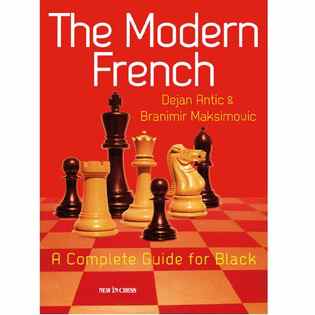Modern French, The
Branimir Maksimovic, Dejan Antic

The French Defense has never been as popular an answer to 1.e4 as the Sicilian or 1…e5 but it has always had dedicated followers. The last few years have witnessed a large number of books on the subject (Watson, Vitugov, Moskalenko, Williams, McDonald, etc.) which would seem to indicate that supporters of 1.e4 e6 are increasing. The latest addition to the literature on this opening is The Modern French by Dejan Antic and Branimir Maksimovic.
Even the most dedicated French players and compulsive opening book buyers must have their limits, so the first question to ask is if this work is needed with all the recent books on the subject. Keep in mind the publisher, New in Chess, has put out two fine works by Moskalenko (The Wonderful Winawer and The Flexible French) the last few years.
To answer this question it is helpful to examine the contents of The Modern French and compare it with other recent entries in the field. This tome is unquestionably an opening repertoire book and as such most closely resembles the works of IM John Watson and GM Nikita Vitugov, but it is also substantially different.
The latest editions of the two aforementioned books offer the reader a repertoire with backup systems each meeting 3.Nc3 with not only multiple lines of the Winawer (3…Bb4) but also the McCutcheon 3…Nf6 4.Bg5 Bb4. Vitiugov also covers capturing on e4 on the third and fourth move. Offering these alternatives makes these books attractive to a wider number of French players but for amateurs below 2400, especially those with limited study time, the need for alternative backup lines is far from essential.
The Modern French prefers to specialize. It sticks to one answer against White main tries (3.e5, 3.Nd2 and 3.Nc3). These consist of 1.e4 e6 2.d4 d5 3.e5 c5 4.c3 Nc6 5.Nf3 Bd7 against the Advance, Morozevich’s 3…Be7 against the Tarrasch and the McCutcheon (suddenly a very popular line to write about) after 3.Nc3. There is also in-depth coverage of the Steinitz (3.Nc3 Nf6 4.e5).
Since all three books (Play the French and The French Reloaded) are roughly similar in length this means the two Serbians are able to focus more attention on the variations they do cover, offering more prose explanation in particular. This should help to make their work more accessible to club players but there are risks for stronger players. The narrow opening repertoire places them in danger of being caught in an opening surprise or finding a key variation suddenly in a crisis with nothing to fall back on. To be fair The Modern French does offer variety albeit in a more limited way. For example: after 1.e4 e6 2.d4 d5 3.Nc3 Nf6 4.Bg5 Bb4 5.e5 h6 6.Bd2 Bxc3 7.bxc3 Ne4 8.Qg4 both 8…g6 and 8…Kf8 (the first choice of the authors) are analyzed.
Those who play the variations of the French on offer in The Modern French will be well served by this book which is neatly produced with an easy to read two column format. Curiously, in this age of Chess Base, where mistake free diagrams should be a given, gremlins have been at work (see page 43 for example).
Recommended
